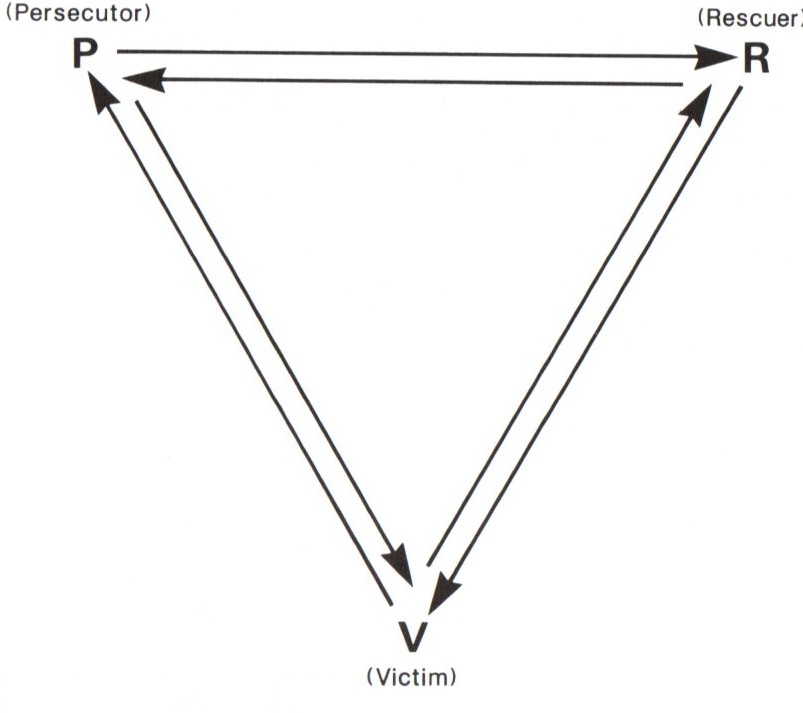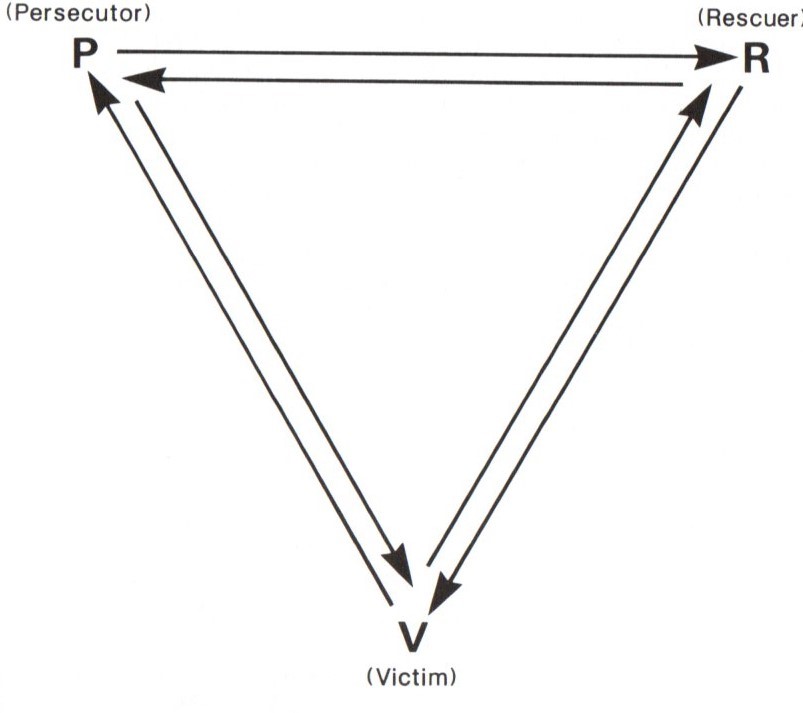This name, The Karpman Triangle, may mean little to you.
However, if I say Rescuer, Persecutor and Victim, your ears may prick up. These are terms that are used in everyday conversation.
I want to say something about the Karpman Triangle, sometimes labelled The Drama Triangle as it may offer insight into uncomfortable feelings generated in certain relationships you have in your life, today.
The Drama Triangle illustrates one set of Games humans play without knowing it! I say more about this at:
If you look at my entry on self-esteem, you will see my account of Life Positions, and the Transactional Analytic (TA) notion of ‘OKness’. Our levels of self-esteem can play a large part in shaping our Life Position and our ‘place’ on the Karpman Triangle.
The diagram at the top suggests how, in some relationships, we can adopt certain roles.
Three roles identified by Karpman
PERSECUTOR: some-one who puts others down. This can be subtle and, indeed, usually is. Commonly the Life Position adopted is: I am OK, You are Not OK.
RESCUER: some-one who responds by offering help from a ‘one-up’ position. This is commonly: I am OK; You are not OK.
VICTIM: some-one who feels one-down. This is commonly I am Not OK; You are OK.
Most of us will have been aware of adopting all three of these roles, or Life Positions, at some time in our lives. However, if I am to help cast light on how these roles impact on our self-esteem, it is important to keep in mind three elements of the Triangle:
- the tendency we have to seek out a ‘fit’ in some of our relationships. When feeling Not OK, we may follow an impulse to seek others who will reinforce that position. Victims seek out Persecutors and Rescuers seek out Victims.
- the result of seeking such a ‘fit’ in our relationships is that we can ‘turn the tables’: for Victims will find Rescuers wanting and for Persecutors to feel hurt when a Victim turns on them. It’s for that reason that many therapists are reluctant to offer advice and guidance; too often it can come to an unhappy end. Any readers not sworn at me after trying out some of the many small experiments on the web-site?!
- How come does this happen? Part-answer: to justify hanging on to our ‘favourite’ Life Position. For example, the Persecutor can then say to themselves: “I told you so, what are they like ….” The Victim can say “no matter what I do, I get let down.... ” The Rescuer can say “I will just have to try harder to be helpful…..”. Look no further than the TV series Fawlty Towers for example after example of this feature.
Why adopt a ‘favourite’ position on the Triangle? Part-answer: To make patterns in our life, to make life predictable and to give meaning to things we do. In particular, it serves to sustain the familiar feeling (uncomfortable, but familiar).
Too often the familiar is the preferred place to be, even when it hurts. Despite the hurt, change can be difficult to generate quite often.
Now you may be reading this and thinking: it’s his professional responsibility to be a Rescuer, that is, to help people. It is my view that I am there to help, but not from the Rescuer position. My way of helping, as I see it, is to work with another to move themselves on. Maybe, even rescue themselves, but not be Rescued.
There is a large difference between the capital R (Rescuer) and my ‘small r’ rescuer. The difference is to do with motivation and direction. A Rescuer desires to help another for their own benefit – to meet some personal need. A rescuer acts to support another as they work themselves out of that hole – and only for the time it takes to climb out of the hole. A Victim depends on others to help sustain passive helplessness. A victim is some-one temporarily in a hole, using their energy and creativity to climb out of it, and actively seeking out others to support them in that journey, but not to complete the journey on their behalf.
The Karpman Triangle in a graphic form
Note that we can move between roles. By the way, when there are three people about, problems can rise when each adopts one role and all three move about!!

EXPERIMENT
Can you think of a recent event where you felt uncomfortable? Where were you? Who were you with? What happened? Make some brief notes about this incident. When you consider the people involved:
- What was your Life Position: were you OK?
- What was your Position in relation to others? Was it I’m OK, You are Not OK, or what?
- As the incident unfolded, what was the outcome and how did folk seem to feel about that result? Did Life Positions – Rescuer, Victim or Persecutor – change?
- Did you start out: I’m OK and end up Not OK? Did other person appear to start out ‘OK’ and then look/sound Not OK?
- How do you account for the changes in Life Position you felt and observed?
Leave your notes and return to them some time later in order to consider if you have more to say.
Also, consider a few ‘standard’ questions:
what might I do next time I am in a similar situation?
How might I stay in the I am OK position?
What might stop me staying I’m OK and You are OK when I am with some-one else?
Often, you may need to seek out ways to assert yourself – not to be aggressive, but say what you want and to ask for what you need from that person.
Leads that might help
So what ACTIONS might be included in a small, safe experiment?
